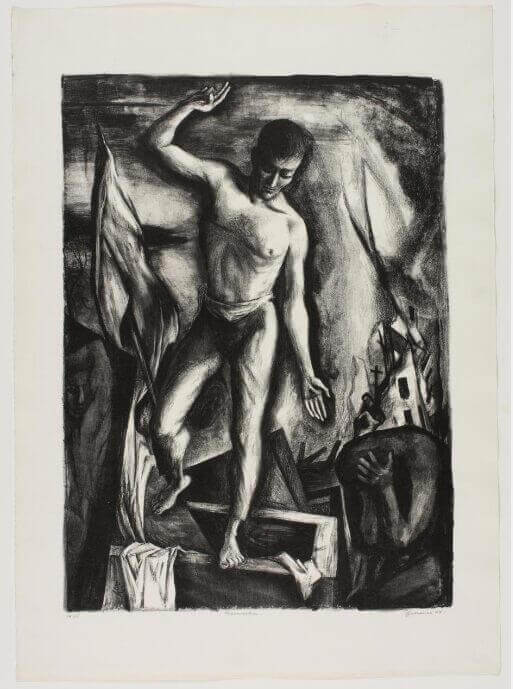Spruance Benton
Benton Murdoch Spruance, born in Philadelphia in 1904, was an influential artist whose work transcended the boundaries of painting and lithography to impact the broader art community significantly. Educated in local schools, Spruance initially studied architecture at the University of Pennsylvania. However, his true passion led him to the Pennsylvania Academy of Fine Arts and the Graphic Sketch Club, where he honed his skills in painting and graphic arts.
During his junior and senior years at the Academy, Spruance won the prestigious William Emlen Cresson Traveling Scholarship, allowing him to study in France. It was in Paris, at the studio of Jacques and Edmond Desjobert, that he first experimented with lithography in 1928—marking the beginning of his illustrious career. In the same year, he married Winnifred Glover, who remained a source of strength and inspiration throughout his life.
Though Spruance was known for his paintings, his most significant contributions were in the realm of graphic art, particularly lithography. At a time when etching was the preferred medium, Spruance stood out by focusing on lithography and pioneering color printing techniques. His prints were widely exhibited and won numerous awards, establishing him as a major figure in the art world. His reputation continued to grow, leading to commissions for murals and book illustrations.
Spruance’s prints offer a unique chronological record of his times, reflecting his experiences and his compassionate nature. His work remains a testament to his artistic talent and his keen understanding of the human condition.
Beyond his artistic achievements, Spruance was a dedicated advocate for the art community. He played a pivotal role in founding the Philadelphia chapter of Artists Equity, giving individual artists a strong voice in community affairs. His appointment to the Philadelphia Art Commission in 1953 was a turning point; he was instrumental in passing an ordinance that required one percent of the cost of public buildings to be allocated for works of art. This initiative significantly enriched Philadelphia’s public art landscape.
Spruance’s natural gifts as a teacher and administrator were recognized through numerous awards, honorary degrees, and administrative appointments at various Philadelphia institutions. Teaching was more than a profession for him; it was a vital function of the artist. He brought a deep understanding of the learning process and a creative approach to his teaching methods.
Together with colleagues Jerome Kaplan and Samuel Maitin, Spruance helped establish Prints in Progress, a program designed to bring printmaking to young people in Philadelphia’s public schools. This initiative, conceived by Walter L. Wolf and supported by the Philadelphia Print Club, allowed students to participate in printmaking demonstrations, fostering a new generation of artists.
Spruance’s impact on the art world was profound and enduring. His works are preserved in a memorial collection at the Free Library of Philadelphia, established in 1968 by Emerson Greenaway, the library’s director and a close friend of Spruance. This collection, comprising over 450 prints, studies, color separations, photographs, and memorabilia, serves as a valuable resource for the public and a testament to Spruance’s legacy.
Throughout his career, Spruance received numerous honors, including the Philadelphia Art Alliance Medal of Achievement and membership in the National Academy of Design and the American Institute of Architects. His most masterful works, a series of twenty-six lithographs based on themes from “Moby Dick,” were created between 1965 and 1968 and are regarded as some of his finest achievements.
Benton Spruance continued to create and innovate until his death in December 1967. His dedication to his craft, his contributions to the art community, and his compassionate nature are remembered and celebrated to this day. Spruance’s life and work remain an inspiration, embodying the spirit of creativity and service to the arts.
Resurrection 1944

Collections: Free Library of Philadelphia, Philadelphia Museum of Art